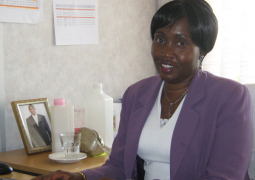Environmental problems and concerns
The need for environment statistics arises from the following problems and concerns: Problems: Coastal erosion, depletion on natural resource base, loss of soil fertility, deforestation, pollution (air, land and water), waste management, atmospheric emissions, rapid population growth, amongst others.
Concerns: Sound management of the environment to attain sustainable development, poverty reduction, and acceptable health of the population and the environment.
Initiative:
The first ever initiative to compile and collate some form of comprehensive environment and environment-related statistics originated from the World Bank support in the implementation of the Gambia Environmental Action Plan (GEAP)(1995-2000).
Framework:
The consultant that was hired to design a reporting framework for the Monitoring and Assessment (M&A) strategy of GEAP, introduced a matrix, which was designed to structure the State of the Environment Report (SOER) by a mix of economic sector and, pressure, state and response model.
Approach:
The M&A strategy introduces a multi-sectoral approach for data collection whereby a number of cooperating departments and NGOs were encouraged (payment of some form of allowance), and required to provide pure environment or environment related data for completing a comprehensive indicator matrix which the National Environment Agency (NEA) maintained.
Data collection efforts:
The National Environment Management Act, 1994, PART X: INFORMATION, EDUCATION AND PUBLIC AWARENESS
(1) empowers the NEA to gather, analyse, manage and disseminate environmental information
(2) the Agency shall have access, subject to any other law, to all existing environmental information of a public nature and shall coordinate the management of environmental information
This mandated the Agency to release the State of Environment Report (SOER) of The Gambia at suitable regular intervals. The first SOER for the Gambia was released in 1997. However, the data collection and compilation activities for the second SOER are currently experiencing difficulties with the end of the GEAP project due mainly to financial constraints.
Owing to the rising demand for statistics on the environment, at national, regional and international levels, the Central Statistics Department (CSD) established an environment statistics unit in 1997. The unit was not fully operational because of bottlenecks such as computer equipment, standardization, training, etc. Further more, collaboration between the unit and the NEA has not been close and effective enough.
Need to update and improve
Available environment data in various departments are to varying degree outdated. Concerned departments and organizations should update their data, in particular, data obtained through adhoc surveys. Existing surveys and databases can be improved and used for more information on the environment. Existing information mechanism on the environment is not on a sustainable footing.
AVAILABILITY and SOURCE OF ENVIRONMENT DATA
An important output of the M&A strategy was the first State of the Environment Report (SOER) of The Gambia prepared by the NEA under the auspices of the World Bank. The Data for the SOER were taken mainly from the completed indicator matrices. Broad indicators for monitoring and assessing progress in the implementation of the GEAP objectives have been selected after due consultations with actors and stakeholders.
The Structure of the SOER: Geophysical characteristics; People environment and Development; Agriculture, Forest and wildlife resources; Aquatic and wet land resources, Population; Health and human population; Energy; Industry; Tourism; Mining; Environmental policy, planning and quality; Environmental awareness; and Trends and scenarios. Some of the environment data revealed by the SOER are:
It was estimated that 12.5 tons/ha/year is eroded from frequently cultivated soils having 2 per cent slope. (FAO fertilizer project, 1993)
The predicted rate of forest destruction is 6 per cent per annum. There are sixty-six forest parks. Agricultural cultivated area increased from 274,100 ha in 1980 to 336,000 ha in 1988 resulting in lost of some forest area. The open and closed forests combined declined from 333,200 ha to 108,700 ha between 1972 and 1980. Between 1972 and 1980 the estimated annual decline rate was 28000 ha. The open and closed forest area of total land area was 6.5 per cent in 1988. A national forest inventory (1983) is available.
A species list for mammals was drawn up in the late 1960’s, 67 species of mammals excluding some rodents and bats were recorded. A total of 507 species of birds have been recorded from The Gambia (Gore, 1990) of which 220 are known to have bred within the country. It is considered possible that a further 27 species also breed intermittently.
The Gambia has a continental self of approximately 3,855 km2. Its fishing grounds have a potential to produce about 70,000 metric tons of pelagic and demersal fish annually. At present it is estimated that fishermen operating within the continental shelf are landing between 7,000 and 10,000 tons annually from trawling and, between 15,000 and 20,000 tons through artisanal fishery.
The estimated volume of sand extracted annually for construction and other purposes was approximately 100,000 to 160,000 m3.
Coastal erosion in The Gambia has been estimated at a rate of 2 metres annually.
Deep aquifer is estimated to hold 80,000 Mm3 of water. Whereas, shallow aquifer is estimated to hold 125 Mm3 of good quality of water.
The most important energy resources in The Gambia is the fuelwood which provides more than 80 percent of the total primary energy needs of the country. More than 90 percent of the population depends on fuelwood for domestic cooking. Petroleum is the second most important source of energy in the country, which accounts for about 11 percent of total primary energy requirements.
Overall, the total energy consumption increased by 6.8 percent from 337.62 thousand tonne oil equivalent (TOE) in 1993/94 to 362.44 thousand TOE in 1995/96.
Data gaps
There are several approaches, which can be used to monitor the environment. A wide variety of indicators can be proposed depending on the specific data needs, the issues under consideration and the cost of collecting the required data. However, efforts are being made by the UNSD to develop a standardized and harmonized sets of indicators on the environment which will take into account specific data needs, the cost of collection and the need for international comparison by developing a somewhat flexible framework for environment statistics.
The data gaps, which are stated in this paper, are gaps in terms of the specific data needs of institutions in the Gambia and, in terms of a foresight on comprehensive environment statistics, which may be suitable for national policy issues and international comparison.



